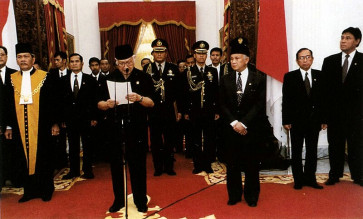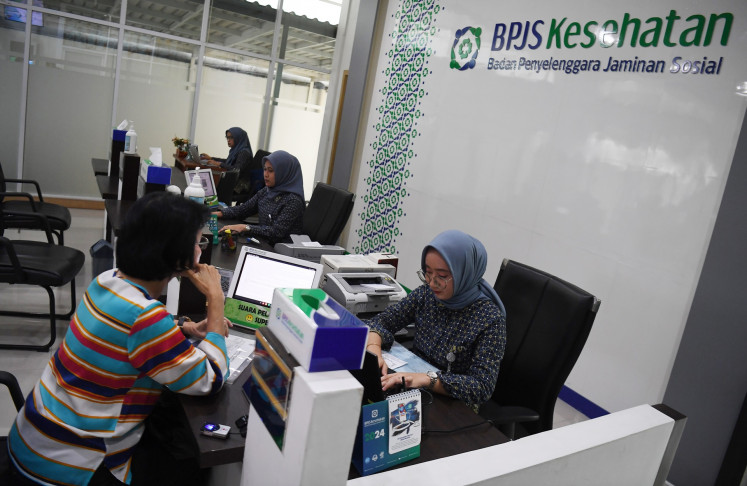Popular Reads
Top Results
Can't find what you're looking for?
View all search resultsPopular Reads
Top Results
Can't find what you're looking for?
View all search resultsInvestors to spend more on palm oil refineries
Indonesia, the worldâs biggest palm oil producer, will spend at least US$2
Change text size
Gift Premium Articles
to Anyone
I
ndonesia, the world's biggest palm oil producer, will spend at least US$2.7 billion to build crude palm oil (CPO) processing facilities until 2014 to further boost the country's CPO production capacity, an executive from the palm oil producer association has said.
'The investments will be channeled by 20 local and foreign processors, 12 of which will pour more than Rp 1 trillion ($101.4 million) into the palm oil downstream industry,' Indonesian Vegetable Oil Refiners Association (GIMNI) executive director Sahat Sinaga said in Dumai, Riau, recently.
The companies, including Sinar Mas Group, Musim Mas Group and Permata Hijau Group, are all developing oleochemical and oleofood plants.
The new facilities will boost Indonesia's processing capacity to 39.46 million tons a year in 2014, which will comprise 30.9 million tons for refining and fractionation capacity, 4.22 million tons for oleochemical production capacity and 4.34 million tons for biodiesel manufacturing capacity of 4.34 million tons.
In the first quarter of this year, investors have spent around $1.02 billion on new processing facilities. The new investments are expected to increase the country's total processing capacity to 30.9 million tons a year by year's end, a 19.31 percent increase from the past year.
The total processing capacities aimed for this year will consist of 25.1 million tons a year for refining and fractionation, up 24.88 percent from last year, about 2.2 million a year for oleochemical production and about 3.6 million tons a year for biodiesel manufacturing.
Local industry players have said that the inflow of such sizeable investments was attributed to the government's decision to change the export tax structure in late 2011, which effectively makes investments in the downstream industry more attractive.
The new tax structure generates a margin of export tax on crude palm oil and downstream products, such as RBD palm olein of between 5.5 percent and 9.5 percent, making Indonesian products more competitive than those produced by Malaysian producers.
Under the new tax regime, the export tax on processed palm oil products declines from 25 percent to 10 percent.
At the same time, a progressive tax is also charged on crude palm oil (CPO) with levies starting at 22.5 percent whenever the commodity's prices shore up beyond $750 per ton. For every $50 price rise from the ceiling, exporters must pay an export tax of 1.5 percent.
This measure supports the Industry Ministry's aim to see palm oil exports comprise 60 percent processed products and 40 percent crude palm oil by 2015.
Prior to the introduction of the tax rule, CPO made up 60 percent of overall exports, while processed palm oil represented the other 40 percent. However, a marked change took place last year that saw processed oil account for 61 percent of total exports, while CPO represented 39 percent.
Sahat said that the domestic downstream industry aimed to push up processed palm oil output for exports to 21.7 million tons this year, up 4.63 percent from last year. This figure would account for 62.6 percent of Indonesia's palm oil exports throughout 2013.
While the new tax rule proved to help boost the utilization of domestic refining capacity and to provide a competitive edge for Indonesia's palm oil exports, it should be further supported by other policies to spur more industry growth, he added.
'The impact of the tax rule has been positive but we need other instruments to draw more sizeable investments in the future,' Sahat said, referring to easier procedures to obtain a tax holiday facility and a simplified tax system, particularly for the payment of value-added tax restitution.
Introduced in late 2011, the tax holiday facility offers five-to-10 year tax breaks in five industrial sectors ' base metal, oil refining and petrochemicals, renewable energy and telecommunication equipment ' with an investment of at least Rp 1 trillion.
In the palm oil downstream industry, the facility has been given to Unilever Oleochemical Indonesia, a local unit of consumer goods giant Unilever Indonesia, which has spent $133 million to build an oleochemical refinery in Sei Mangke, North Sumatra.










